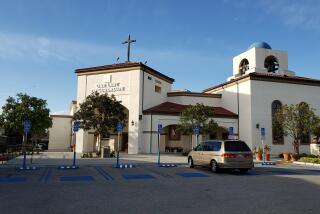Priest Is Indicted in Nun’s Slaying
- Share via
CHICAGO — A grand jury in Toledo, Ohio, has indicted a priest on a charge of aggravated murder in the killing of a nun 24 years ago.
Father Gerald Robinson was arrested April 23 on suspicion of strangling and stabbing to death Sister Margaret Ann Pahl.
Robinson’s lawyer, Alan Konop, said Monday that the priest would plead not guilty at an arraignment hearing, expected to take place next week. If convicted, the 66-year-old Roman Catholic priest could face life in prison.
Robinson, who presided over Pahl’s funeral Mass, was released from jail Monday afternoon, after supporters and parishioners posted enough property to cover his $200,000 bail. “Father Robinson is doing better now, but how well can he be expected to be?” Konop said.
Pahl’s body was discovered inside the sacristy of Mercy Hospital’s chapel on April 5, 1980, the Saturday before Easter.
In a crime that shocked this predominantly Catholic town, the 71-year-old nun had been strangled, stabbed 27 to 32 times and covered with a white altar cloth. Although police said there was no evidence of rape, they acknowledged that the killer had positioned Pahl’s body to appear as if she had been sexually assaulted.
Within weeks, all leads had evaporated and investigators set the case aside.
Then last year, a woman approached a sex-abuse panel at the Toledo diocese and said Robinson and other priests had sexually abused her during disturbing rituals. A letter detailing her assertions was given to the Ohio attorney general’s office, which passed the material on to police and prosecutors in Toledo.
In December, authorities relaunched their investigation into Pahl’s slaying. Late last month, bolstered by what police described as “new eyes seeing new things in old evidence,” authorities arrested Robinson.
Unlike many cold cases, the police were not relying on DNA evidence to make an arrest. Officials with the Toledo Police Department said they had used an age-old technique, called “blood transfer pattern,” to connect the evidence to Robinson.
Experts say the technique helps authorities figure out why a piece of evidence has blood on it, and how the blood got there. The practice has been used to lift bloody fingerprints off objects, said Herbert Leon MacDonell, founder of the Bloodstain Evidence Institute in Corning, N.Y. It also has been used to identify murder weapons, particularly those with odd shapes or unique markings.
Toledo Police Department officials and Lucas County prosecutors would not discuss details of the evidence from the 1980 crime scene.
Robinson could not be reached for comment Monday. His lawyers declined to discuss details of the case.
More to Read
Sign up for Essential California
The most important California stories and recommendations in your inbox every morning.
You may occasionally receive promotional content from the Los Angeles Times.












